

Greenlee. Kit of no parts examples. Cloth covered wire from Sundial Wire. W:Blut. A Processing library for mesh creation and manipulation. G speak. Generator.x 3.0 : from code to atoms. An openLAB Masterclass with Marius Watz Participants will explore how software processes can be combined with digital fabrication to produce physical objects that are the result of dynamic software systems, opening new fields for artists, designers and other creative people.
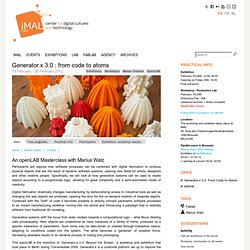
Specifically, we will look at how generative systems can be used to create objects according to a programmed logic, allowing for great complexity and a semi-automated model of creativity. Digital fabrication drastically changes manufacturing by democratizing access to industrial tools as well as changing the way objects are produced, opening the door for the on-demand creation of bespoke objects. Combined with the “craft” of code it becomes possible to directly connect parametric software processes to an instant manufacturing workflow, turning bits into atoms and introducing a paradigm that is radically different from traditional 3D modeling. Encoded Matter « introspector. “Even though the constant search for complete transparency brings newer, ‘better’ media, every one of these new and improved technologies will always have their own fingerprints of imperfection.

While most people experience these fingerprints as negative (and sometimes even as accidents) I emphasize the positive consequences of these imperfections by showing the new opportunities they facilitate.”Rosa Menkman in Glitch Studies Manifesto This projects explores traits – or fingerprints – introduced by low-cost 3D printing driven by computation. Writing code and digital fabrication are not neutral design media – i.e. they facilitate modes of thinking and making and introduce a form and degree of mediation. For this project mediation is not seen as something negative that needs to be avoided, but actively explored as a feature.
Inventables Electronics Batch 4 and 5 - ShapeOko. Full and Premium ShapeOko kits, batches 4 and 5, purchased through Inventables come with a complete set of electronics, which includes the following: Electronics Parts Layout (note: the black and yellow cable is not included and is not needed for batch #4 or batch #5 assembly) Arduino and grblShield The Arduino is the heart of the electronics.
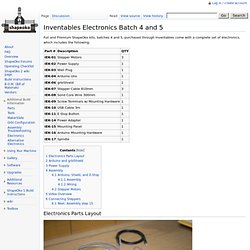
It contains an AVR Processor, a USB connector, and I/O pins. The grblShield plugs into the top of the Arduino, and is what takes the signals grbl generates and drives the steppers. Power Supply When the selector is positioned to the 24v location on the side of the power supply, the unit provides 4.0amps at 24 volts. The connector that ships with the power supply comes with pre-stripped wires on one end and a barrel connector on the opposite end. Please note, the current pictures show the DC connector pig tail with a red wire (+) and a black wire (-). Black == (-) black/white or red == (+) Assembly Arduino, Shield, and E-Stop. Just another WordPress.com site. Digital Crafting. Just another WordPress.com site. Using RS232 with Parker/Compumotor Zeta 6104 - Page 2 - NI Discussion Forums. Sabaq, the one I posted now looks funny and outdated.
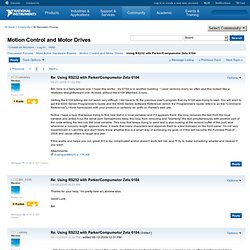
It could take quite a while to try to figure out what it is doing wrong by going back and forth with you. I maybe could post a more recent version, which is in 5 vi's and needs a testing wrapper around it to pass references to controls in. But it is more complicated, and more dedicated to the specific things I am doing. I don't know if it is worth your while. I am, though, controlling a two axis system with LV now, and have to be able to set speeds and destinations, move to relative or absolute locations, predict times required to move some distance with the acceleration and deceleration accounted for, read the motor position, check various flags like the P-CUT input and the limit switches, pass unusual reply strings back to the main program, and so forth.
Resources « Conversations with spaces. Jie Qi – 2010. Input/Output Paper A pair of origami papers in which the red paper senses how it is being folded and the white paper follows.
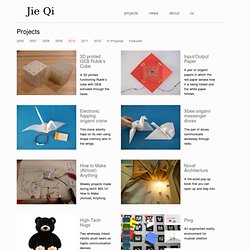
High-Tech Hugs Two wirelessly linked robotic plush bears as haptic communication devices Ping An augmented reality environment for musical creation littleBits. Learnable Programming. Here's a trick question: How do we get people to understand programming?
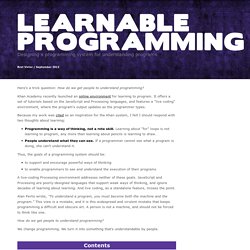
Khan Academy recently launched an online environment for learning to program. It offers a set of tutorials based on the JavaScript and Processing languages, and features a "live coding" environment, where the program's output updates as the programmer types. Because my work was cited as an inspiration for the Khan system, I felt I should respond with two thoughts about learning: Programming is a way of thinking, not a rote skill. Learning about "for" loops is not learning to program, any more than learning about pencils is learning to draw.People understand what they can see. Thus, the goals of a programming system should be: to support and encourage powerful ways of thinkingto enable programmers to see and understand the execution of their programs A live-coding Processing environment addresses neither of these goals. Alan Perlis wrote, "To understand a program, you must become both the machine and the program. "